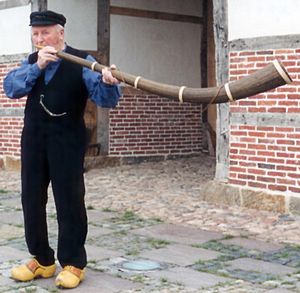Midwinter horn facts for kids
The midwinter horn is a special wooden trumpet played during the Christmas season. You'll find it in parts of the Netherlands and nearby areas of northern Germany. People in these regions call it by different names, like midwinterhoorn (Dutch) or Middewinterhorn (German). It's also sometimes called the dewertshorn or adventshorn.

Contents
What is a Midwinter Horn?
A midwinter horn is usually about 1.3 meters (4 feet) long. But their size can change, and modern ones are often longer. These horns are made from slightly curved tree trunks. Trees like alder, birch, or willow are good choices. Alder is thought to be the most traditional wood.
How Midwinter Horns are Made
To make a horn, a tree trunk is cut in half lengthwise. Then, the inside of each half is carefully hollowed out. The walls are left about 1 centimeter (half an inch) thick. After hollowing, the two halves are joined back together. They can be glued, or held with metal rings. Traditionally, people used willow or bramble branches to tie the halves.
To make sure the horn doesn't leak, it's often dipped in water. This helps seal any small cracks. Right before playing, water is usually poured inside too.
The Mouthpiece and How to Play
A special mouthpiece is added to the horn. This part is usually made from elder wood. It's cut at a slant, similar to an ancient Celtic instrument called a carnyx. Because of this slant, the horn is played sideways.
In the past, some midwinter horns were made from metal sheets. These were built in sections to get the right curve. But today, people prefer the traditional wooden horns again.
Sounds of the Horn
Unlike the much larger alphorn, you hold the midwinter horn in your hands. You don't rest it on the ground. Traditionally, players hold it over water. This was thought to make the sound louder, but it doesn't really work that way.
A midwinter horn can make about eight different notes. However, each horn is unique. The notes it makes can be a bit different from another horn. Because of this, midwinter horns are usually played one at a time, not together.

When and Where Midwinter Horns are Played
Playing wooden horns in midwinter is a very old custom. It happens on both sides of the border between the Netherlands and Germany. In recent years, this tradition has become popular again. You can see it in places like the County of Bentheim in Germany. It's also popular in Twente in the Netherlands.
A Christmas Tradition
Today, playing midwinter horns is a way to announce and celebrate Christmas. The horns are sounded from the start of Advent (late November or early December). They continue to be played until Epiphany on January 6th.
Many villages and towns in this border area have groups of horn players. They take turns sounding their instruments. This tradition is so important in the Dutch regions of Gelderland and Overijssel. It has been listed as a national heritage tradition of the Netherlands.
History of the Midwinter Horn
The first time the midwinter horn was written about was in 1815. But many people believe the tradition is much older. It might come from ancient Germanic customs around Yule. Back then, horns might have been blown to call for help. They might also have been used to scare away bad spirits.
There's a very old document called the Indiculus. It mentions that sounding horns was a way for the Saxons to ward off bad weather. This shows that horn playing has a long history.
In Friesland, playing ox horns dates back a thousand years. This custom continued in parts of West Twente until the late 1800s. It was brought back to life in Markelo in 1988.
During World War II, people even used the horns to signal. They would warn neighbors if a patrol was coming.
Some experts, like J. J. Voskuil, have different ideas. He thought the midwinter horn came from medieval nativity plays. These plays often showed shepherds blowing horns. He believed the modern tradition was a new kind of folklore. It was more about local identity than ancient pagan beliefs.

